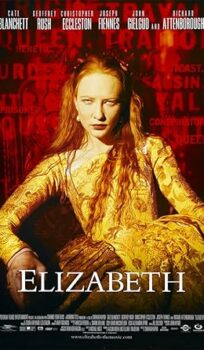Elizabeth(1998)
Submitted by Julio M
8 Oscar nominations, including Best Picture ; Winner for Best Makeup.
Short pooper:
Her acquaintance with the famous Babington Plot against her, thanks to Walsingham (Geoffrey Rush), moves Elizabeth (Cate Blanchett) to have all involved conspirators, led by Howard, Duke of Norfolk (Christopher Eccleston), arrested and executed for treason. She, however, spares her once-lover Lord Dudley (Joseph Fiennes) but severs all ties with him; she then commits her life to England and assumes the mantle of “The Virgin Queen”.
Longer version:
The passing of the Act of Uniformity, by which The Church of England, broken away from the Vatican, was established as the Nation’s unifying religious institution, sends shockwaves that help streamline the plot concocted by Duke Norfolk to remove Elizabeth from power. Oblivious to the conspiracy growing around her and not knowing a Vatican priest is aiding Norfolk, Elizabeth meets The Duke of Anjou (Vincent Cassel), who aims to win her over as part of a strategic alliance between France and England, but she rebuffs him, due to her affair with Lord Dudley.
Baron Cecil (Sir Richard Attenborough), who firmly believes Elizabeth must marry a man in order to bolster her public image and make herself look respectable, challenges her over her carefree attitude and, believing it would force her to make up her mind, reveals that Lord Dudley was already a married man, thus making their affair adulterous. Dejected, Elizabeth confronts Dudley with this, which he has no choice but to confirm, for which they end their liaison, and she disowns him. Moreover, she discovers Duke Anjou does crossdressing, for which she also rejects his marriage proposal. These two revelations convince Elizabeth that marrying a man would just open a door for someone else exerting over her and her decisions power she did not want to give to anyone.
An attempt against her life takes place, with evidence heavily pointing towards the Scottish Queen Mary of Guise (Fanny Ardant). In retaliation, Elizabeth arranges for her right-hand Sir Walsingham to meet Mary secretly in Scotland, supposedly to discuss Duke Anjou’s marriage proposal, only for Walsingham to kill Mary; as this causes a breakdown of relations with France, Cecil strongly warns Elizabeth that she must get, in turn, in the good graces of Spain, to which she responds by banishing him from her presence. It is at this point that Walsingham comes across concrete evidence of the historically famous “Babington Plot”, whose implications extended into Catholic elements of the Church and the Court, and looked to eliminate Elizabeth and have Mary Queen of Scots -daughter of Mary of Guise- marry the Duke of Norfolk and become the Queen of a Unified England and Scotland.
When Elizabeth learns of this, she orders the arrest of the Vatican priest in possession of the damning evidence, who confesses the details of the plot and the names of those involved, which include Norfolk himself and, to her dismay, Lord Dudley. With the exception of Dudley, whom she decided to spare so he could live with the guilt of his actions and as a reminder of how she gave in to the possibility of being killed, they are all arrested and sentenced to death for treason.
As the movie ends, we see images and title cards informing that, from that point on, Elizabeth inspired herself in Divinity, gave up mundane attitudes and remodeled herself into “The Virgin Queen” – manifested into being given the famous ethereal look she came to be known for-, fully committing herself to the cause of ruling England, which she did for the following 45 years, and kickstarting The Golden Age.

